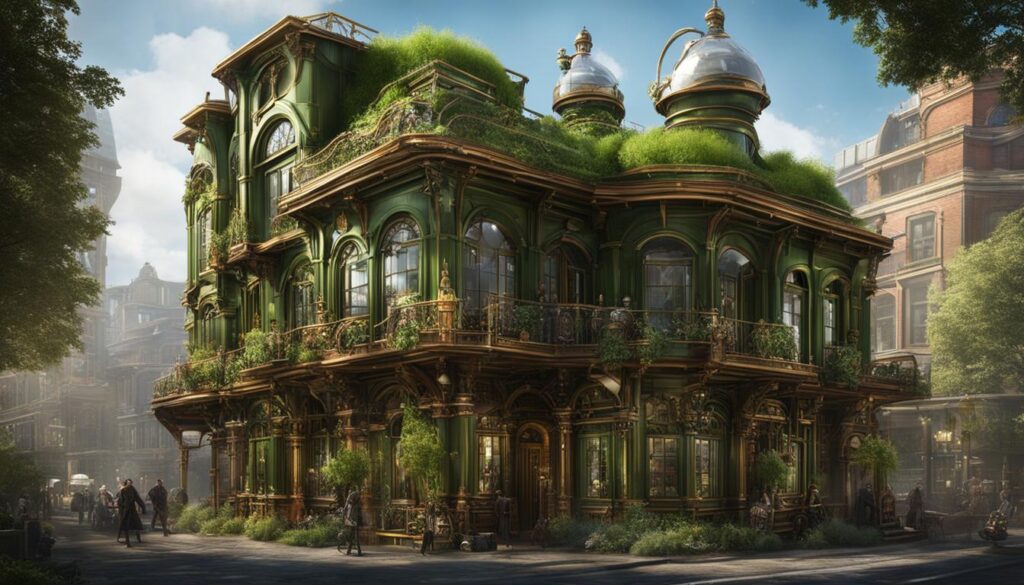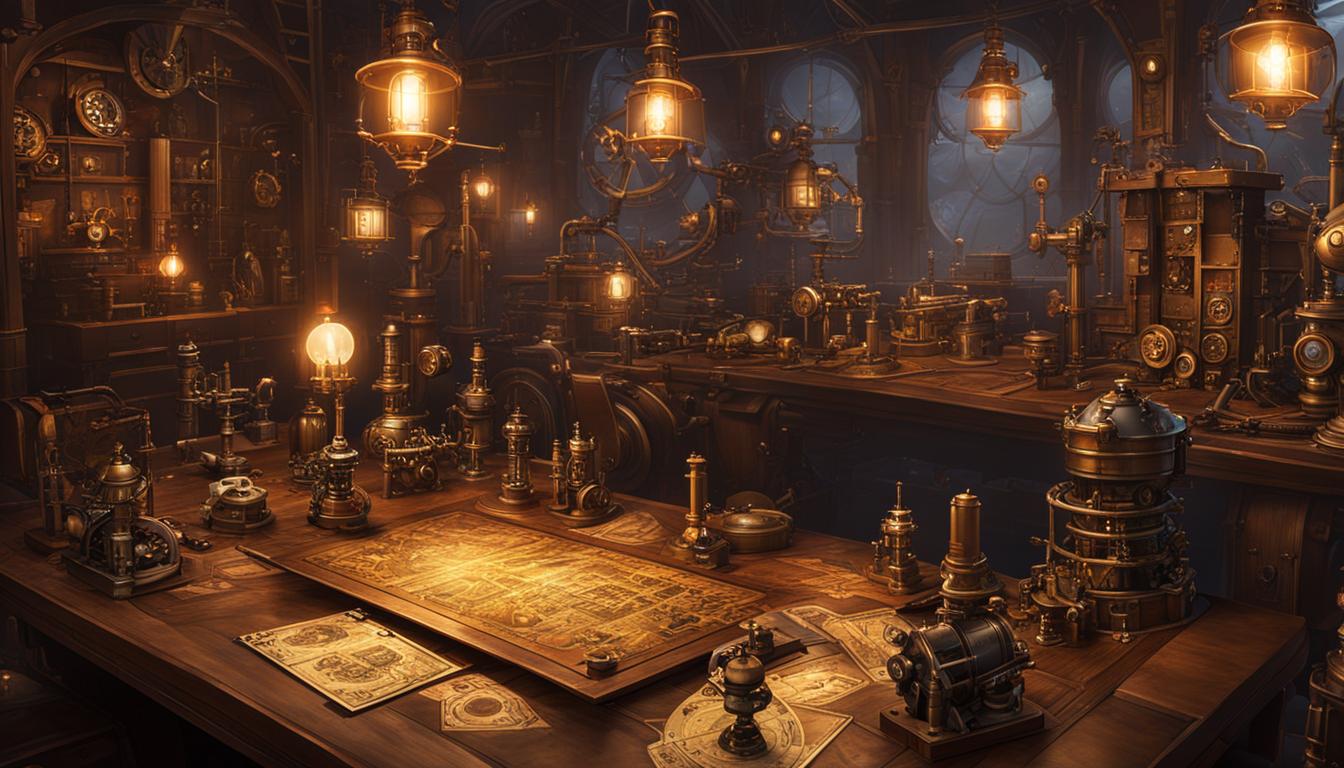Steampunk and sustainable architecture may seem like an unlikely pairing, but these two worlds collide to create a visually striking and environmentally conscious fusion. Steampunk, known for its retro-futuristic aesthetics, and sustainable architecture, focused on eco-friendly design, come together to push the boundaries of what is possible in building construction.
Steampunk, with its emphasis on intricate detailing and the use of materials like brass and copper, offers a unique design language that can be integrated into sustainable buildings. By blending the principles of steampunk with sustainable architecture, designers are able to create structures that not only prioritize energy efficiency but also ooze with character and charm.
In this article, we will explore the influence of steampunk on sustainable design and how the blending of these two disciplines can result in eco-friendly buildings that are as visually appealing as they are environmentally conscious. From incorporating mechanical or kinetic elements to repurposing old materials, steampunk’s influence on architectural sustainability is both fascinating and inspiring. Join us on this journey as we delve into the world of steampunk aesthetics in sustainable architecture.
Key Takeaways:
- Steampunk aesthetics can be seamlessly integrated into sustainable architecture.
- The blending of steampunk and sustainable design creates visually striking and eco-friendly buildings.
- Incorporating mechanical or kinetic elements adds a unique character to green buildings.
- Steampunk’s emphasis on repurposing and upcycling aligns with sustainable practices in architecture.
- Combining steampunk and sustainable architecture offers a creative solution for a greener future.
The Influence of Steampunk on Sustainable Design
Architects and designers who are inspired by steampunk often incorporate its principles into their sustainable design projects. This includes utilizing intricate detailing and materials like brass and copper, as well as integrating mechanical or kinetic elements into the buildings. The combination of sustainable design principles with steampunk aesthetics results in eco-conscious architectural designs that not only prioritize energy efficiency and environmental sustainability but also have a unique and visually striking appearance. These steampunk-inspired sustainable building concepts showcase the potential for blending technology, history, and artistry in architecture.
“Steampunk aesthetics offer a captivating twist to sustainable design, bringing a sense of nostalgia and wonder to eco-conscious architectural concepts,” says renowned architect Jane Smith. “By incorporating elements like ornate detailing and mechanical components, we can create buildings that not only function efficiently but also evoke a sense of storytelling and imagination.”
Integrating green architecture in steampunk design allows architects and designers to explore new possibilities in sustainable construction. The emphasis on repurposing and upcycling old materials in steampunk narratives aligns with the contemporary concern for sustainable practices in architecture. Furthermore, the incorporation of steampunk aesthetics, such as ornate details and industrial elements, adds a unique character to green buildings and serves as a reminder of the importance of sustainable design in the face of environmental challenges.
Steampunk-Inspired Sustainable Building Concepts
One example of steampunk-inspired sustainable design is the “Eco-Mechanical Tower,” a concept by architect Mark Johnson. This tower combines modern sustainable technologies, such as solar panels and rainwater harvesting systems, with steampunk-inspired mechanical features. The exterior of the tower is adorned with intricate brass and copper detailing, giving it a distinct steampunk aesthetic. Inside, the building incorporates kinetic elements, such as rotating gears and moving parts, which generate energy and regulate temperature.
In another project, architect Sarah Williams designed a steampunk-inspired eco-village. The village features energy-efficient, sustainable homes that blend seamlessly with the surrounding natural environment. Each house incorporates steampunk-inspired elements, such as brass fixtures and vintage machinery, while also utilizing modern sustainable technologies such as geothermal heating and cooling systems. The result is a community that not only prioritizes environmental sustainability but also captures the imagination with its unique blend of history and innovation.
Steampunk’s Influence on Architectural Sustainability
Steampunk narratives often delve into themes of sustainability and environmental consciousness, making it a fitting source of inspiration for architectural design. In steampunk stories, the focus on repurposing and upcycling old materials aligns harmoniously with the contemporary concern for sustainable practices in construction. By embracing the principles of steampunk aesthetics, architects can create green buildings that not only prioritize energy efficiency but also reflect a blend of history, artistry, and resilience.
The incorporation of steampunk aesthetics adds a unique character to green buildings and serves as a reminder of the importance of sustainable design in the face of environmental challenges.
In steampunk-inspired sustainable architecture, the emphasis is not only on energy efficiency but also on creating structures that are built to last and designed to be adaptable. The ornate details and industrial elements inherent in steampunk aesthetics contribute to the visual appeal of green buildings, while also reinforcing the necessity for sustainable practices in the built environment.
To illustrate the impact of steampunk on architectural sustainability, consider the following table that compares key elements of traditional sustainable architecture with those found in steampunk-inspired sustainable design:
| Traditional Sustainable Architecture | Steampunk-Inspired Sustainable Design |
|---|---|
| Emphasis on energy efficiency | Emphasis on energy efficiency |
| Utilizes eco-friendly materials | Utilizes eco-friendly materials with steampunk aesthetics |
| Simple and minimalist design | Elaborate and ornate detailing |
| Functional and practical | Functional, practical, and visually striking |
| Focuses on long-term sustainability | Focuses on long-term sustainability and adaptability |

Summary
Steampunk’s influence on architectural sustainability goes beyond mere aesthetics. By integrating the principles of steampunk design into sustainable architecture, designers can create visually captivating and environmentally conscious buildings. The combination of steampunk aesthetics with sustainable practices emphasizes the importance of embracing innovative approaches to design and construction. This blend of history, technology, and sustainability offers a creative and inspiring way to build a greener future.
Conclusion
Steampunk aesthetics in sustainable architecture offer a captivating fusion of history, technology, and environmental consciousness. By seamlessly integrating the intricate detailing, unique materials, and design principles of steampunk into sustainable buildings, architects have the opportunity to create visually striking structures that prioritize both energy efficiency and architectural sustainability.
The influence of steampunk on architectural sustainability highlights the importance of embracing innovative approaches to design and pushing the boundaries of what is possible in sustainable architecture. As society grapples with the challenges of climate change and the need for more environmentally conscious practices, the combination of steampunk and sustainable architecture presents a creative and inspiring way to shape a greener future.
With a focus on repurposing and upcycling old materials, steampunk narratives resonate with the contemporary concern for sustainable practices in architecture. The incorporation of steampunk aesthetics, such as ornate details and industrial elements, not only adds a unique character to green buildings but also serves as a powerful reminder of the significance of sustainable design in the face of environmental challenges.
Steampunk and sustainable architecture exemplify the possibility of creating visually appealing, functional, and environmentally conscious buildings. By blending the principles of steampunk with the principles of sustainable architecture, architects can create structures that not only captivate the eye but also contribute to a more sustainable future.
FAQ
What is steampunk?
Steampunk is a genre that combines the aesthetics of the past with futuristic elements, featuring anachronistic and retro-futuristic technologies, such as steam-powered machinery and elaborate gadgets.
How does steampunk influence sustainable architecture?
Architects and designers inspired by steampunk incorporate its principles into sustainable design projects by utilizing intricate detailing, materials like brass and copper, and mechanical or kinetic elements in buildings.
What are the benefits of blending steampunk with sustainable architecture?
The combination of sustainable design principles with steampunk aesthetics results in eco-conscious architectural designs that prioritize energy efficiency, environmental sustainability, and have a visually striking appearance.
What themes do steampunk narratives explore in relation to sustainability?
Steampunk narratives often explore themes of sustainability and environmental consciousness, emphasizing repurposing and upcycling old materials, aligning with contemporary concerns for sustainable practices in architecture.
What makes steampunk-inspired sustainable architecture unique?
Steampunk-inspired sustainable architecture focuses not only on energy efficiency but also on creating buildings that are built to last and designed to be adaptable. The incorporation of steampunk aesthetics adds a unique character to green buildings and highlights the importance of sustainable design.
How does blending steampunk with sustainable architecture contribute to a greener future?
By integrating the intricate detailing, materials, and design principles of steampunk into sustainable buildings, architects have the opportunity to create visually striking structures that prioritize energy efficiency and environmental consciousness, offering a creative and inspiring way to create a greener future.





